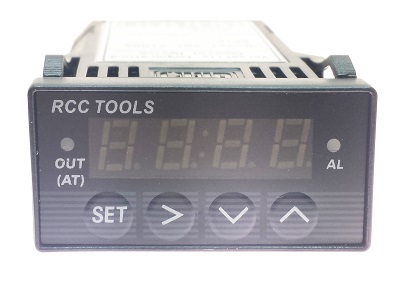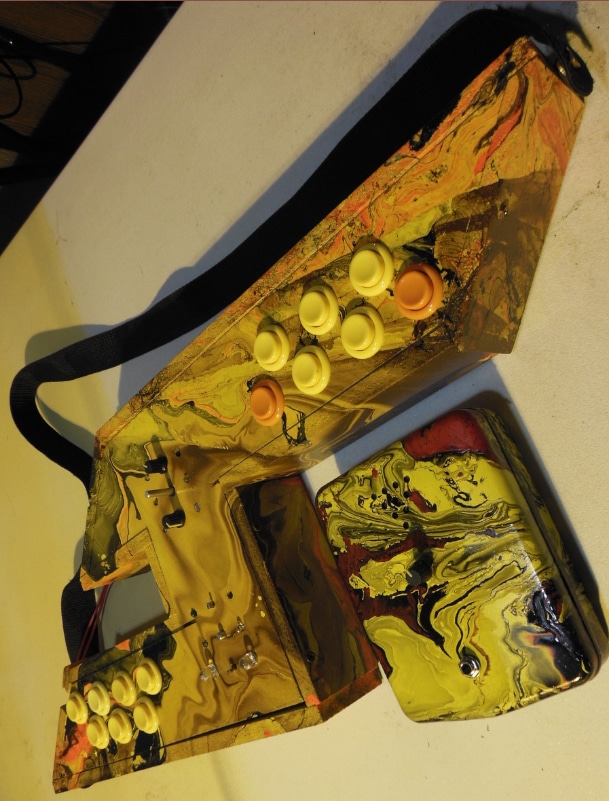

My Journey On A Custom Built Roadway
The clearest beginnings of RCCtools come into focus around 2011, when I created the Mobitar (motherboard guitar). Part keytar, part arcade machine, and part transformer robot, the Mobitar is a custom MIDI keytar made with three old Dell motherboards, classic arcade buttons, eight pot knobs, and a Hale Micro UMC32 board. It got me into a local newspaper’s entertainment section and helped put on a few great live shows.
My dream at the time was to develop better electronic instruments for DJ’s and performative producers/beat makers. The goal was to create gear that would give DJ’s some more interesting ways to perform, so it didn’t appear that they were just pressing play and sitting back. I wanted to make instruments that would allow for a more demonstrative live show, so the audience could get a better look at what the performer was doing and how the music came together on stage. I had no idea at the time that this path would eventually lead me here into this industry.
A couple of years later, after zero sales, I figured the economics would never work making these keytars out of old computer motherboards. The final price was just too steep for such a niche instrument, and I didn’t know how to reach the people who would appreciate them enough to pay for them. I then began working on a wooden version, which was equipped with a heavily modded DIY synthesizer kit. I dubbed this one the “Trigguitar”.The Trigguitar was another keytar-like instrument, but one very different than the Mobitar in function, and the very first one that I decked out with a hydro dipped paint finish.
This synth was customized with an Arduino microcontroller which sent pulsed signals to the synthesizer input to create the sounds. It also used some color changing LED’s which modified the sound waves as they changed colors. It wasn’t the most practical synthesizer, but it was one of the most fun and interesting projects I had made at the time. This was the project that made me fall in love with the hydro dipped marble style that you see in some of the enail kits offered here to this very day.
I figured that making the body out of wood would be more economically viable than the Mobitar’s motherboard-based construction. Unfortunately, the economics didn’t quite work out with Trigguitar either. The high cost of production, total demand/sale price, and my lack of marketing awareness eventually put some deadly strains on the venture.
I had absolutely no idea how to market my gear outside of eBay, word of mouth, or social media. The model was sadly doomed to fail from the very start since I had no idea how to market online or even research how viable this idea was in the first place. I hope to start it back up as a hobby or a side gig one day, but for now it is shelved except as a business idea. I still use the Mobitar every once in a while to put chopped-up samples into beats when I get some spare time.
It was time to go back to the drawing board. I continued delivering sandwiches a few more years while planning my great escape. After drudging and dredging for various corporate franchises for about a decade, I made it a goal to find a way to do something I could take pride and ownership in.
The new mission was to figure out a way to start something awesome that was also economically viable. I had already wasted thousands of dollars, hundreds of hours, and needed to apply what I learned and loved to something with a wider audience and better affordability.
Fast-forward to 2015, and I’m marble dipping electronic nail controllers instead of musical instruments. When I first discovered these devices they were all at least four times more expensive than the standard units you see today ($400-$500). These prices were way out of reach for me, so I knew I would either need to figure out how to make it myself or come across some sort of miracle money if I ever hoped to own one.
I also figured I was probably not be the only one in this boat. There had to be more than a few others that wanted to own an e-nail but could not afford the outrageous prices of the e-nails available in 2016. It was simply an economic necessity which turned the page on a new chapter that would develop into the RCCtools brand.
My introduction into the world of electronic temperature control was slow and cumbersome, as many beginnings are. It began with some Google searching and experimenting. I knew I had enough knowledge and confidence from tinkering with DIY electronics to experiment, so I tried out a few ideas and threw together some components that I already had at home. Most of these early ideas were basically near-disasters, and none of them worked. Not even close.
Eventually, I found the enail subreddit, where a user named j4yt3x made a nice little post about how to get started making your own “digital e-nail”. This was the DIY enail guide that really put things within reach, although I still had a long way to go.
After finally sourcing all of the parts needed, my e-nail dreams were starting to come into focus. The dream of having an electric dab nail at home was getting closer and closer! After going over and over j4yt3x’s post and deciphering some very poorly translated instructions for a foreign-made PID controller I had purchased, the magic moment finally came. At last I had my very own working electrically-heated nail controller! This was my moment of triumph as I set my torch aside and pondered my next steps.
A small inventory of electronic enclosures was procured, along with a ton of paints. I came up with a variety of color schemes and started applying my hydro-dipping experience and techniques to the cases. It was so cool seeing what came out with each dip! Hydro-dipping is truly an awe-inspiring technique that surprises you every time with a result that can only be partially predicted (just like the forces of nature themselves; which heavily steer the process and outcome). I now had the knowledge and experience to put out the most affordable and heady unit possible for others that I knew had to be in the same situation as I was just a week before.
Soon after I started selling my first controllers on eBay, the hair straightener method of pressing rosin was also just starting to become popular. I realized that my electronic controllers could also be applied to rosin pressing, so I began sourcing different heating coils for this purpose and developing on my own DIY plate sets. I had a grow space at the time, so it naturally made a lot of sense to also try to rig up my own set of plates and test out this new and awesome #dabtech that made it much more safe and accessible to process one’s own flower at home on a relatively small budget.
Long story short: I lacked the proper metal machining tools that other rosin platen manufacturers were using. Since I was much less capable in this area compared to e-nail controllers, I dropped the rosin plate production. I also no longer had a good grow space, and therefore not much material to press and test my plates on.
From then on, controllers became the main focus. I tried out all of the nail styles and materials, and tested any accessory I could get my hands on. Many hours were spent (and still are spent today) sourcing the best products at the best price point for everyone.
About two years ago, 3D printers finally became affordable, so I decided to finally dive into this arena head first. I had been waiting for prices to come down since the first $3000 Makerbot unit came out, and the time had finally come! That was when my 3D printed holders/stands started to come more into play, as well as some custom e-nail boxes.
Since then, I’ve been 3D modeling and printing custom gear according to user feedback and different ideas that I come up with. Besides customized controllers, I’ve spend most of my time designing and sourcing related and handy items for the e-nail sets to compliment the dabbing experience.
Some of my other (and most interesting hobbies) include: music production, video production, general product design/inventing/3D modeling & 3D printing, experimental gardening/composting, brewing/fermenting, and bonsai tree refinement.
Check out some of my music at Soundcloud, Beatstars, or on YouTube.
RCCtools designs and creates the most unique and affordable electric dab nail controllers available; while also curating and packaging the best related gear for the best value. I work every single day to bring the best, most functional and affordable concentrate gear to all you dabbers out there. I appreciate all of the great feedback and encouragement I have received. It really does mean a lot!

About Conner Goertzen
I am a DIY electronics enthusiast who has been 3D printing since 2018, making custom e-nail controllers since 2016, and putting together custom electronic instruments since 2011. Check out some of my music at Soundcloud, YouTube, and Beatstars
